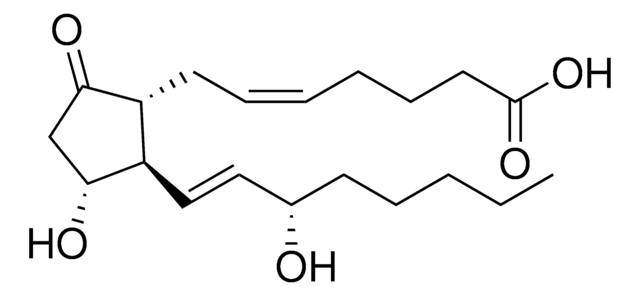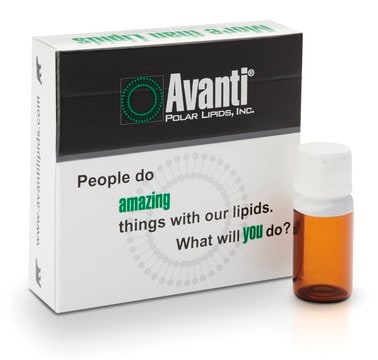L5011
Leukotriene D4
~50 μg/mL (in methanol/ammonium acetate buffer, 70:30, pH 5.6), ≥97%
Sinónimos:
LTD4
About This Item
Productos recomendados
Nivel de calidad
Ensayo
≥97%
concentración
~50 μg/mL (in methanol/ammonium acetate buffer, 70:30, pH 5.6)
Condiciones de envío
dry ice
temp. de almacenamiento
−70°C
cadena SMILES
CCCCC\C=C\C/C=C\C=C\C=C\[C@@H](SC[C@@H](N)C(=O)NCC(O)=O)[C@@H](O)CCCC(O)=O
InChI
1S/C25H40N2O6S/c1-2-3-4-5-6-7-8-9-10-11-12-13-16-22(21(28)15-14-17-23(29)30)34-19-20(26)25(33)27-18-24(31)32/h6-7,9-13,16,20-22,28H,2-5,8,14-15,17-19,26H2,1H3,(H,27,33)(H,29,30)(H,31,32)/b7-6+,10-9-,12-11+,16-13+/t20-,21+,22-/m1/s1
Clave InChI
YEESKJGWJFYOOK-GKWRKXFUSA-N
Acciones bioquímicas o fisiológicas
Características y beneficios
Envase
Palabra de señalización
Danger
Frases de peligro
Consejos de prudencia
Clasificaciones de peligro
Acute Tox. 3 Dermal - Acute Tox. 3 Inhalation - Acute Tox. 3 Oral - Flam. Liq. 2 - STOT SE 1
Órganos de actuación
Eyes
Código de clase de almacenamiento
3 - Flammable liquids
Clase de riesgo para el agua (WGK)
WGK 3
Punto de inflamabilidad (°F)
49.5 °F
Punto de inflamabilidad (°C)
9.7 °C
Equipo de protección personal
Eyeshields, Faceshields, Gloves, type ABEK (EN14387) respirator filter
Elija entre una de las versiones más recientes:
¿Ya tiene este producto?
Encuentre la documentación para los productos que ha comprado recientemente en la Biblioteca de documentos.
Nuestro equipo de científicos tiene experiencia en todas las áreas de investigación: Ciencias de la vida, Ciencia de los materiales, Síntesis química, Cromatografía, Analítica y muchas otras.
Póngase en contacto con el Servicio técnico











